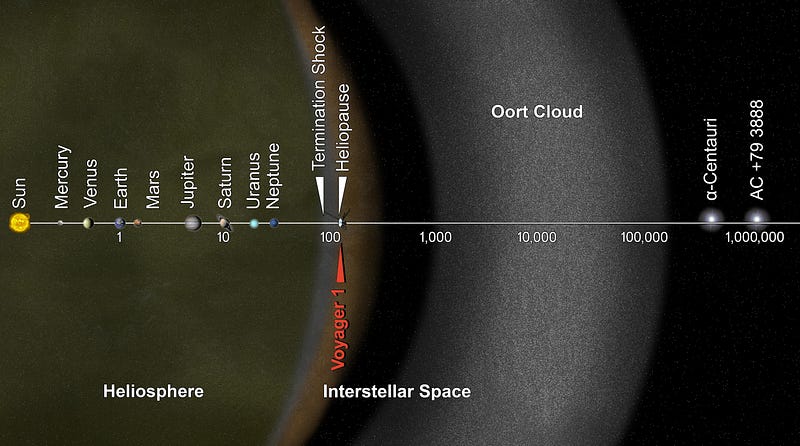Exploring the Mysterious Oort Cloud: A Hidden Edge of Space
Written on
Chapter 1: The Limits of Our Solar System
The outer Oort Cloud spans an incredible circumference of approximately 188 trillion kilometers. While the true endpoint of the universe remains a mystery, we do have a clearer understanding of what defines the outer limits of our solar system. This boundary exists over 10 billion kilometers from Earth, a remarkable distance indeed. However, "seeing" this region isn’t quite accurate, as it has never been directly observed. This leads us to ponder: “Why do comets seem to emerge spontaneously?”

Temperatures within the Oort Cloud are extremely frigid, often hovering just a few degrees above absolute zero. An Astronomical Unit (AU) is defined as the average distance from the Earth to the Sun, which is approximately 150 million kilometers. In the 1950s, Dutch astronomer Jan Oort began investigating the peculiar behavior of comets, particularly those with exceedingly long orbits around the Sun. He observed a fascinating pattern: despite traveling in varied directions, these comets appeared to originate from a single distant region of space.
Oort hypothesized the existence of a vast spherical area filled with icy comets at the very edge of our solar system. When external forces nudge these comets toward the Sun, they ignite and become visible for brief moments in our sky. He termed this region the "Oort Cloud." Although it remains unseen through telescopes due to its distance and darkness, scientists believe it provides an excellent explanation for the origins of these wandering comets.
Thus, while it resembles the belief in an unseen entity, all evidence points toward this mysterious Oort Cloud, the secretive source from which comets seemingly arrive.
Chapter 2: The Structure and Composition of the Oort Cloud
In earlier theories, the Oort Cloud was thought to be significantly more massive—up to 380 times the mass of Earth. Today, however, its exact mass remains uncertain, likely being less than a few Earth masses. It’s essential to visualize the Oort Cloud as a bubble that envelops our solar system, contrasting with the more aligned and flat structures of the planets and the asteroid belt.
The Oort Cloud is believed to be an isotropic source of comets, meaning these comets can approach from any direction in space. It consists of enormous icy bodies and frozen rocks drifting through the cosmos. These remnants stem from the solar system's formation, never having been incorporated into planets or other celestial entities.
The cloud is generally divided into two regions: an inner cloud, known as the Hills Cloud, and an outer cloud. The inner cloud begins at around 2,000 to 5,000 AU from the Sun and is thought to be denser, possibly taking a disk or toroidal shape. The outer cloud extends from the boundary of the inner cloud to distances of 50,000 AU or even up to 200,000 AU from the Sun. This outer region acts as a thick spherical shell around the solar system, from which most long-period comets originate.
In this area, the influence of the inner solar system's planets diminishes, while gravitational forces from nearby stars and the Milky Way take precedence. These external influences can trigger comets to journey from the Oort Cloud toward the Sun, often due to nearby stars passing closely, galactic tidal forces, or the dynamics unique to the cloud itself.
Section 2.1: The Oort Cloud's Impact on Earth
Alongside solar gravity, the Oort Cloud is also subject to the gravitational pull of neighboring stars and the Milky Way. It’s believed that other stars possess their own Oort Clouds, with the potential for their boundaries to overlap. Our solar system maintains a delicate balance of gravitational forces among celestial bodies, and without this cloud, our planet's fate could be drastically altered.
But does the Oort Cloud have a direct impact on our daily lives? Not particularly. However, in the early stages of Earth's history, comets likely played a crucial role in delivering water and organic compounds to our planet, which may have been vital for the emergence of life. As they neared the Sun and disintegrated, they released gases, dust, and larger particles into the interplanetary medium, some of which eventually reached Earth as meteorites or micrometeorites, contributing to its chemical variety.
While extremely rare, it is theoretically possible for a comet from the Oort Cloud to be deflected in such a way that it could collide with Earth. However, before worrying about that possibility, it's wise to first familiarize yourself with the risks posed by our closest celestial neighbor.
Final Thoughts: The Oort Cloud's Significance
Despite being invisible and unreachable, the Oort Cloud is deemed an essential element in understanding the origins of comets. Its structural uniqueness sets it apart from other solar system formations, as it is not flat but rather spherical, enveloping the solar system. It likely comprises two distinct sections: a denser inner cloud and a more extensive outer layer.
Although the Oort Cloud's direct influence on Earth is limited, it plays a significant role in maintaining the solar system's equilibrium and may have contributed to the essential components necessary for life.
Thank you for reading, and stay tuned for more intriguing insights about our universe!